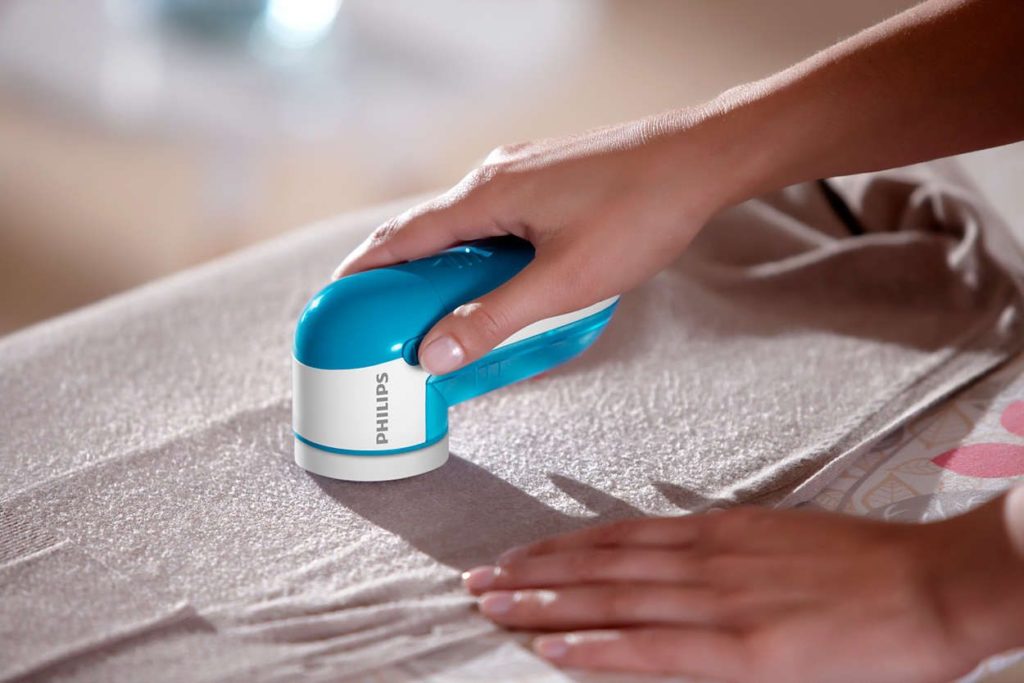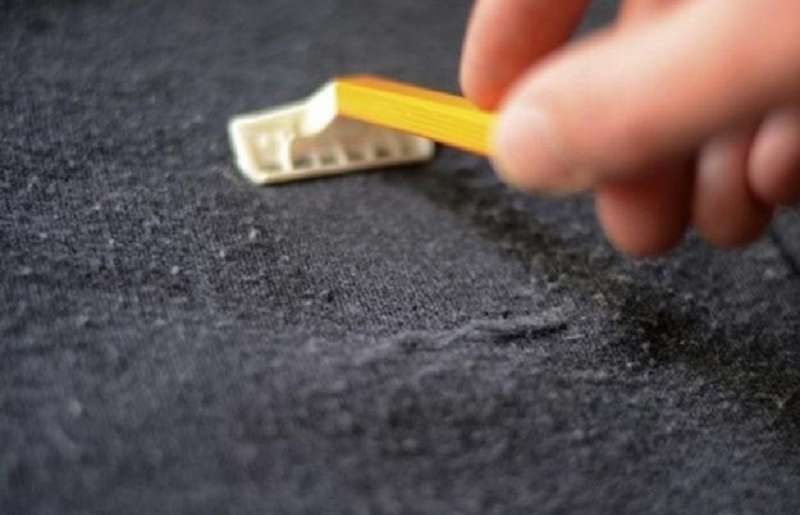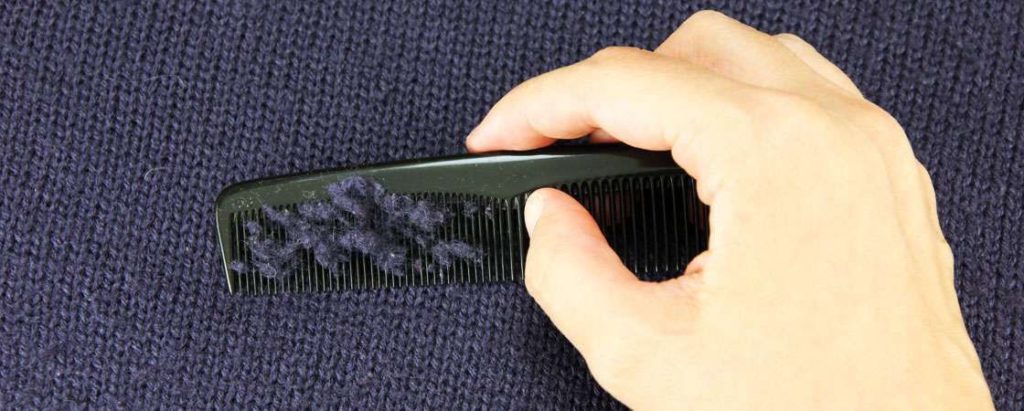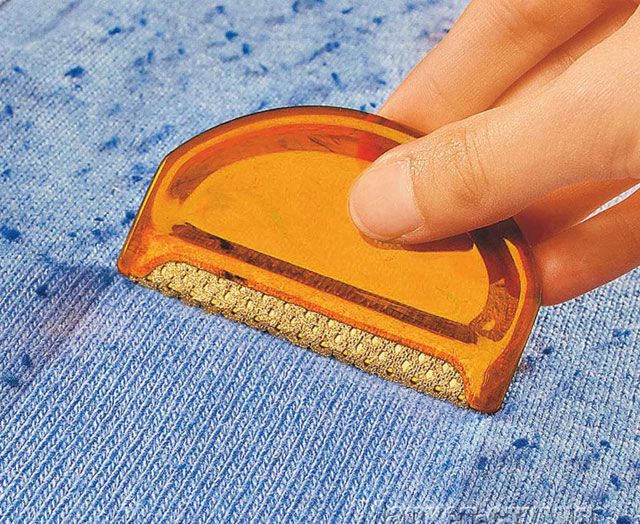Pills suddenly appear on a recently purchased item. The coat immediately loses its presentable appearance. You can fix the problem at home or contact a professional.
Reasons for the appearance of pellets
Loose fibers on clothing can migrate to the surface of the fabric. When rubbed, they begin to curl into small balls called pellets. They are formed when the fabric is exposed to rougher surfaces.

Some time after purchase, you may notice that the coat is coughing. This means that there are clumps of fibers on the clothing.
Which material will cough and which will not?
Insufficient twisting of the threads leads to the fact that when clothing is used, the fibers begin to curl into lumps. Low-density fabrics and knitwear are most susceptible to this. The more synthetic additives, the more stable the pellets. The following fabrics do not wrinkle: natural linen, cotton, silk.

IMPORTANT! On synthetic materials without special treatment, you can often notice the appearance of persistent pills.
Mixed species are very popular today. The addition of synthetics allows you to improve the properties of natural materials. The result is wear-resistant, elastic fabrics. If they contain a large percentage of synthetics, then the appearance of balls of fabric fibers is inevitable.
Why do pills appear on my coat?
Small lumps on clothes form after prolonged wear and a large number of washes. The fibers begin to tangle.
ATTENTION! The appearance of the coat is affected by the constant wearing of a bag or backpack. In places of friction, the pile rolls off.
If the technology was violated during the production of the material, this will also contribute to the appearance of balls from fabric fibers. The coat may fray due to insufficient twisting of the threads or long constrictions.

Improper care of clothes also leads to the appearance of pilling. This occurs as a result of washing at elevated temperatures or using products that are not suitable for this type of fabric. It is important to follow the recommended drying regime for the product.
How to remove pellets
There are several ways to help solve this problem. First of all, it is necessary to take into account the composition of the fabric and the manufacturer’s recommendations for caring for it.
Toothbrush

A simple method is used for fabrics with soft long pile. The toothbrush should move in the direction of the pile so as not to damage the fabric.
Special machine

The simplest and most convenient solution would be to purchase a special device for cleaning coats from pellets. The machine has the ability to adjust the height of the knives so as not to damage the fabric.The device will allow you to quickly get rid of the problem.
Dry cleaning

You can contact specialists. If you take an item to dry cleaning, dirt and pellets will be removed from its surface. For this purpose, special tools and modern equipment are used. Proper care of your coat will extend its service life.
Razor

The most dangerous and at the same time efficient method is used for knitted clothes with a smooth texture. It is not used for cashmere and angora. The razor is also not used for mohair. If it is sharp, there is a high risk of damaging the surface of the product. During the procedure, the material is stretched; you need to work with the machine carefully.
Scotch

If fiber balls have just begun to appear, then use a simple method. The adhesive tape is glued to the desired area and then removed with a sharp jerk. It is better to give preference to the most adhesive tape, with its help you will be able to remove the maximum number of pellets.
IMPORTANT! An alternative option would be a wide patch.
This method will not eliminate large lumps that have long formed on the surface of clothing.
Scissors

In some cases, you can use improvised means. To get rid of pellets, use nail scissors. But this option will require a lot of time and effort. The labor-intensive method is suitable if there are few lumps on the item.
Comb

Use a small-toothed comb to comb the clothing along the grain. Thorough brushing will help remove fiber balls. If any defects remain after the procedure, they are removed with tape.
Bread crumb

A piece of black or gray bread is dried in the oven. It is then used to remove lumps from the surface of clothing. Movements of the breadcrumbs are carried out from top to bottom.
Sandpaper

Clothes are processed until defects are completely eliminated. To do this, choose fine-grained sandpaper. Do not press too hard on the surface of the fabric to avoid damaging it. The method is not suitable for coats with pile.
Hard sponge, scraper

Clean clothes in the direction of the grain. To do this, you need to use a new washcloth. The principle of its operation is similar to other methods.
Three most effective ways
To find a suitable option for dealing with pellets, you need to take into account the composition of the fabric and the presence of lint.
The safest and most effective way is to go to dry cleaning.
An effective method is a special machine, which can be purchased in the store. This method will allow you to quickly and effortlessly deal with lumps on clothes.
If you need to clean a coat with long pile, then using a comb is an excellent solution.
The best method will be the one in which the risk of tissue damage is minimal.
Preventing the formation of pilling on coats

Cashmere and wool coats are usually dry cleaned. Synthetic or mixed fiber items can be washed at home.
If you notice that the coat material is easy to roll, choose a bag and accessories that will not contribute to this process.
To properly care for your clothing, you need to pay attention to the information on the special label. If you follow the manufacturer's recommendations, you will be able to prevent the formation of pellets and extend the life of the coat.


 0
0





